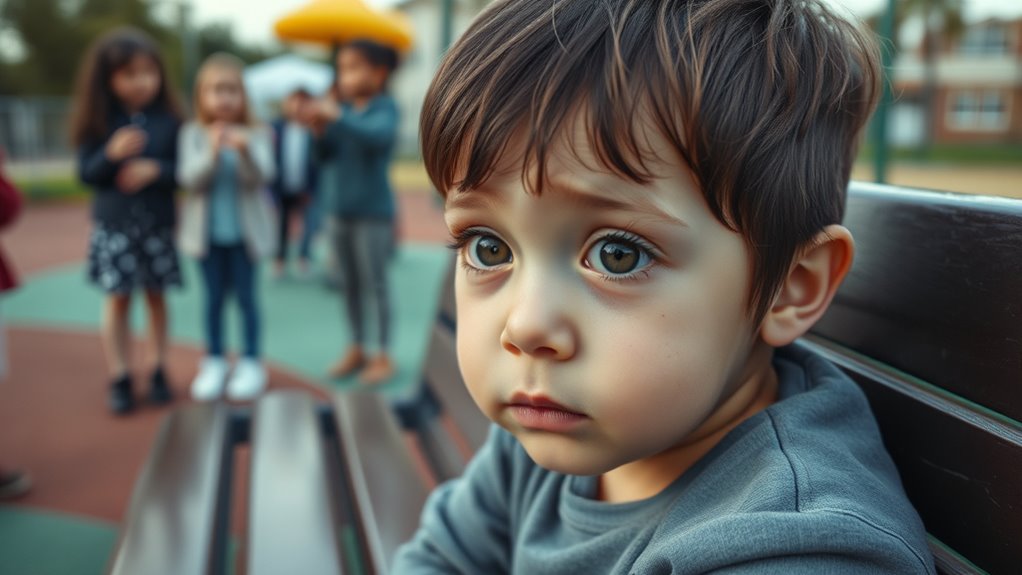To spot bullying early, watch for behavioral changes like increased anxiety, withdrawing from friends, and mood swings. Physical signs, such as unexplained injuries or torn clothes, can also indicate issues. Academically, a decline in grades or frequent absences may signal distress. Pay attention to social dynamics; isolation or changes in friend groups can be red flags. Encourage open communication about school experiences, and if you suspect bullying, consider seeking professional help. There’s more to discover about protecting kids from bullying.
Key Takeaways
- Monitor for signs of increased anxiety or mood changes in children, as these may indicate distress related to bullying.
- Look for physical signs such as unexplained injuries or torn clothing, which could suggest confrontations with peers.
- Pay attention to academic performance; a decline in grades or frequent absences may correlate with bullying experiences.
- Observe social dynamics; isolation from peers or changes in friend groups can be indicators of bullying.
- Encourage open communication about school experiences, creating a safe space for children to express their concerns and feelings.

How can you tell if a child is being bullied? Identifying the signs of bullying early can be essential for a child’s safety and well-being. You should start by observing changes in your child’s behavior. If they show increased anxiety, become reluctant to attend school, or withdraw from social activities they once enjoyed, these may be significant indicators. Such behavioral shifts often signal that something troubling is happening in their school environment.
Physical signs can also point to bullying. Keep an eye out for unexplained injuries, torn clothing, or missing belongings. These signs might suggest that your child has faced aggression from peers. It’s important to take these indicators seriously and approach the situation with care. Parents and caregivers should be vigilant about their child’s physical well-being, as neglecting these signs can lead to further distress. Recognizing patterns of emotional coldness may also be important in understanding the emotional impact of bullying. For example, children experiencing bullying may develop long-term emotional damage if the situation is not addressed promptly.
Be vigilant for physical signs of bullying, such as unexplained injuries or torn clothing, as they may indicate aggression from peers.
Academic performance is another area to monitor closely. A decline in grades or frequent absences can suggest that bullying is affecting your child’s mental health and focus at school. If you notice these changes, it’s essential to intervene early. Engaging with teachers and school staff can provide additional insights into your child’s school life and any issues they might be facing.
Open communication is important. Encourage your child to talk about their experiences at school. Creating a safe space for dialogue allows them to express their concerns without fear of judgment or reprisal. They should feel comfortable discussing their friendships and social dynamics. If they mention feeling excluded or if you notice changes in their friend groups, it might indicate that they’re experiencing bullying.
Pay attention to their social interactions. If your child often seems isolated or if their friendships change frequently, it can be a sign that they’re struggling with bullying. Understanding the social dynamics at play can help you gauge the severity of the situation.
Additionally, be aware that emotional and psychological growth occurs in stages, which may influence how your child copes with social dynamics. Ultimately, addressing bullying requires a proactive approach. By being attentive to the signs of bullying, encouraging open communication, and fostering a supportive environment, you can help your child navigate these challenges. Your involvement is essential in preventing potential mental health problems that can arise from prolonged bullying experiences.
Don’t hesitate to seek help from professionals or school authorities if you suspect your child is facing bullying.
Frequently Asked Questions
What Are the Behaviors of Bullying?
Bullying behaviors often include repeated acts meant to harm or intimidate someone. You might notice physical bullying like hitting or pushing, while verbal bullying could involve name-calling or threats that undermine self-esteem.
Emotional bullying often manifests through exclusion or spreading rumors to isolate someone. Cyberbullying, on the other hand, takes place online, with threats or embarrassing images shared through social media.
Recognizing these behaviors is essential to understanding the impact they’ve on individuals.
What Are the Three Elements of Bullying?
You might think bullying’s just a playground squabble, but it’s a dark storm brewing!
The three elements of bullying are intentional aggressive behavior, a clear power imbalance, and repetition. When someone targets you or another person with harmful actions on multiple occasions, it’s a classic sign.
The bully often wields more power, whether through strength, social status, or resources, leaving the victim feeling trapped in a never-ending cycle of fear.
What Are the First Signs of Bullying?
When you’re observing signs of bullying, pay attention to a child’s behavior. If they’re reporting teasing or feeling threatened, that’s a red flag.
Look for physical signs like bruises or torn clothes, and notice if they don’t want to go to school or join activities.
Emotional shifts, like increased anxiety or sadness, can also indicate distress.
How Do Bullies React When Confronted?
Confronting a bully can feel like stepping into a storm; their reactions can be unpredictable.
When you call them out, they might deny their actions, deflecting blame to you or others. Sometimes, they’ll respond with anger, trying to intimidate you back into silence.
Occasionally, you might see a glimpse of remorse, but often they’ll manipulate the situation to paint themselves as the victim, avoiding true accountability for their behavior.
Conclusion
To sum up, spotting bullying early can make all the difference. Trust your instincts and stay alert to changes in behavior, both in your child and their peers. Remember, “an ounce of prevention is worth a pound of cure.” By being proactive and open in conversations, you can create a safe environment where kids feel supported. Don’t hesitate to intervene if you suspect bullying; addressing it early can help prevent long-term effects.









